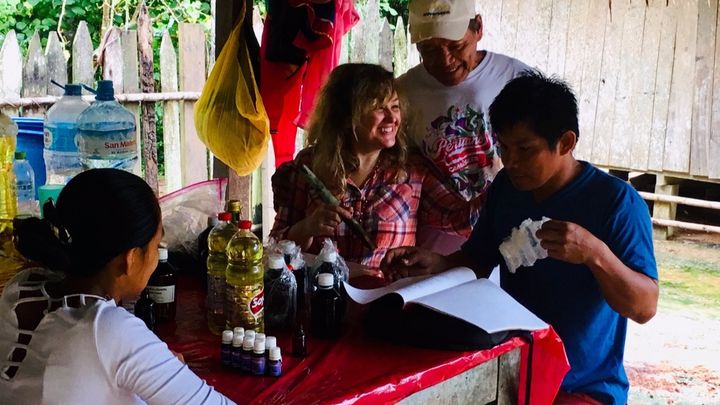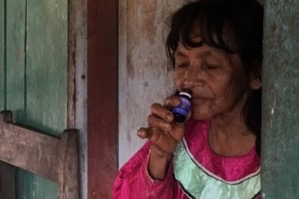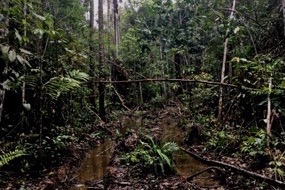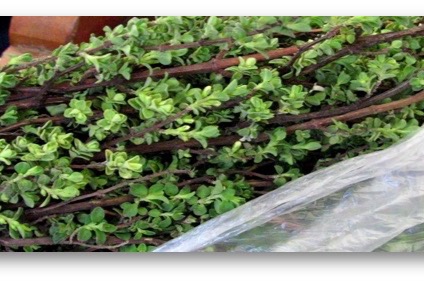
Conservation & Education: Peru
Donation protected
January 2019 I am returning to central and southern Peru for 16 days to carry out Phase 3 of my research and humanitarian work. Your support will not only help protect and conserve one of the world’s most commercially-valued and yet endangered plants (Aniba rosaeodora), it will also help bring economic stability to Peruvians, strengthen collaboration with Peruvian universities, support the well-being of Shipibo and Quechua communities with essential oils and germane training, provide much-needed shoes and school supplies for Peruvian children, and reduce the gap in scientific research on one of the most utilized aromatic medicinal plants throughout South America – the Andean mint commonly known as 'muna' (Minthostachys spp.).
Please find below the objectives of Phase 3, together with background information on completed Phases 1 and 2. In addition to crowdfunding, supporting grants are being sought after. This proposal will be also presented to companies interested in purchasing a CITES-permitted, sustainable source of cultivated rosewood (A. rosaeodora) essential oil, which in turn will help provide Peruvians with jobs and support indigenous communities.
Phase 3 funds are being requested toward flights, transportation on buses/boats, vaccinations, printing and packaging of educational materials and essential oils, translation of legal agreements, guides, shoes and school supplies for village children, DNA analysis, GC-MS analysis, shipments within Peru, on-the-ground translators, accommodation, food, supplies (e.g. batteries, chargers, and water-safe filters), seeds, and bottles and carrier oils. We were most fortunate to have already been gifted the essential oils needed for this phase of our research, thanks to Madeleine Kerkhof of Kicozo.
Your support would be greatly appreciated. Not only will you help contribute to gaps in the scientific literature regarding these precious aromatic species, but you will also help to conserve an endangered plant and its fragile habitat, strengthen the local economy and overall well-being of Peruvian communities, and preserve indigenous knowledge of traditional and aromatic plant medicine.
PHASE 1
Novel research was done throughout northern, central, and southern Peru in 2015 to 1) identify and understand the use of aromatic plant medicine as a form of traditional medicine from the viewpoint of Aromatherapy as practiced in North America, and to 2) assess the conservation status of Peruvian aromatic medicinal plants.
Consequently, 63 aromatic medicinal plants were identified, along with the conditions they are used to treat, as well as their common extraction and application methods. Factors impacting the abundance of aromatic medicinal plants and their conservation statuses were also revealed. The majority of informants who use aromatic plant medicine do so sustainably; they were aware and concerned that their medicine is disappearing as a result of deforestation, overharvesting, and climate change. Two plants of particular concern were rosewood (A. rosaeodora) and muna (Minthostachys spp.).
Although Peruvians are using “aromatherapy” in their daily lives, they expressed a desire to learn more about aromatic plant medicine and its uses. Consequently, my goal was to provide educational instruction on the chemistry and therapeutic benefits of essential oils, as well as cost-effective ways of extraction with higher yields of essential oil. The latter is critical considering that their aromatic medicinal plants are fewer in number and fast disappearing because of climate change, overharvesting, and deforestation.
Peruvians have taken steps to help conserve and protect their aromatic plant medicine for its use in local healing by future generations, yet doing so can be costly and require resources difficult to obtain. Reforestation is one strategy being implemented to help conserve their valued plants.
 Reforestation project: Peru. © Kelly M. Ablard
Reforestation project: Peru. © Kelly M. Ablard
We can also help by establishing sustainable methods of growth and harvesting of essential-oil bearing plants in Peru, providing a market for Peruvian-distilled essential oils which will not only help conserve plants, but also help communities become economically strong, and collaborating with Peruvian universities to demonstrate scientifically the therapeutic value of their aromatic plant medicine.
Further details on Phase 1: ‘Exploring Aromatherapy as a Form of Traditional Aromatic Plant Medicine in Peru’ https://www.kellyablard.com/essential-oils/exploring-aromatherapy-as-a-form-of-traditional-aromatic-plant-medicine-in-peru/
PHASE 2
As a result of Phase 1, the objectives of Phase 2 in 2017 were to 1) locate and identify wild rosewood (A. rosaeodora), which is classified as endangered by the IUCN, 2) explore ways with the Shipibo to cultivate a sustainable source of rosewood for seed saving, distillation, and economic gain, 3) deliver essential oils to Shipibo and Quechua communities, and 4) to provide instruction and educational materials to the healers and leaders of these communities on their therapeutic benefits and applications.
Consequently, semi-mature to mature wild rosewood trees were located. Said plant material was physically confirmed by Juan Ruiz (Universidad Nacional de la Amazonia Peruana), and was further confirmed by chemical analysis of its essential oil performed by Dr. Rosario Rojas (Universidad Peruana Cayetano Heredia). Agreements and business proposals were initiated to secure government land, and Shipibo land to grow A. rosaeodora trees alongside other native essential oil-bearing plants. Essential oils (generously supplied by Stillpoint Aromatics) were donated to Shipibo and Quechua communities and were used to support their healing, while training and educational materials on the therapeutic benefits and applications of the essential oils were given to heads of Shipibo and Quechua villages, plant-medicine healers, schools, and communities. The medicine and sharing of knowledge is helping to support the healing of 1000+ people.
 Rosewood spp.: Peru. © Kelly M. Ablard
Rosewood spp.: Peru. © Kelly M. Ablard
 Shipibo inhaling lemon essential oil: Peru. © Kelly M. Ablard
Shipibo inhaling lemon essential oil: Peru. © Kelly M. Ablard
PHASE 3
The objectives of Phase 3 are to 1) establish legal land and business agreements, 2) gather information and put into effect a plan to cultivate sustainably-managed rosewood in order to acquire a CITES permit for legal exportation of rosewood (A. rosaeodora) essential oil, 3) plant rosewood seeds, 4) deliver essential oils to Shipibo and Quechua communities, 5) continue to provide instruction and educational materials to the healers and leaders of these communities, 6) implement the United Plant Savers (UpS) At-Risk Assessment Tool to survey Minthostachys spp., 7) collect Minthostachys spp. for genetic analysis and specimen vouchers, 8) demonstrate sustainable-harvest methods, 9) ensure a high-quality and ethical source of Minthostachys essential oil, 10) collect A. rosaeodora oil samples for further chemical analysis, and 11) to provide Shipibo children with shoes and school supplies.
Rosewood
Aniba rosaeodora is listed as an ENDANGERED species. According to the IUCN (2017), ‘endangered’ means that natural population numbers decreased ≥50% over the last 10 years or 3 generations, assessments of wild and mature adults (those capable of reproduction) total less than 2500 and the numbers are declining, and there is a 20% probability of its extinction within 20 years or 5 generations. Not only is this species listed as endangered, but it is also protected by the Convention on International Trade in Endangered Species (CITES).
Aniba rosaeodora has significantly and primarily declined because of the unsustainable harvest of its sapwood and heartwood for the essential oil, which is sought after for its high linalool content. Whole trees of all sizes and thus ages are harvested indiscriminately, and their roots are being destroyed. This type of illegal and unsustainable harvesting, as well as illegal logging and distillations, take place in remote locations to reduce costs and the chance of being detected. Unfortunately when these areas are discovered, they show no signs of regeneration. Further, Aniba rosaeodora is impacted by habitat loss and by its illegal acquisition at any cost by Koreans; it is one of the most desired woods used for Korean furniture. Still, the real heart of this serious problem revolves around the essential oil.
 Signs of deforestation and illegal harvesting: Peru. © Kelly M. Ablard
Signs of deforestation and illegal harvesting: Peru. © Kelly M. Ablard
Certainly there is no question about the necessity and high demand for rosewood oil by a multitude of industries worldwide. Unfortunately, the high demand is not met by the supply. It was reported in 2011 that more than 2 million rosewood trees have been destroyed, and population numbers continue to decline. It is estimated that for approximately 40 tons of essential oil, about 4,000 whole trees are annually harvested without signs of regeneration.
Since the 1960s, exploitation levels have declined with the increased use of synthetic linalool, but not nearly enough to prevent the unsustainable and illegal harvesting of rosewood, and the illegal production and trade of its oil. For example, it was announced on September 18th, 2017 that Young Living, an essential oil company, “pleaded guilty in federal court to federal misdemeanor charges regarding its illegal trafficking of rosewood oil and spikenard oil [spikenard is critically endangered on the IUCN redlist] in violation of the Lacey Act and the Endangered Species Act.”
The high demand and cost (US$80/kg) of unadulterated and quality-controlled true rosewood oil backed with a CITES permit limits and complicates the market for retailers and consumers. High-end retailers and makers of perfumes, essential oils, and cosmetics who attempt to obtain true rosewood oil may unknowingly receive adulterated oil.
To learn more about rosewood, and for references, please refer to: ‘Rosewood (Aniba rosaeodora Ducke): Time to Take Heart’ - https://www.kellyablard.com/conservation/rosewood-aniba-rosaeodora-ducke-time-to-take-heart/
Muna
Understanding the environmental chemistry of Minthostachys spp. is just one area that must be further explored in order to deepen our understanding and preservation of this genus, which we know so very little about. Building upon and reassessing our current modicum of knowledge through clinical research, systematic taxonomic classification, conservation genetics, population density assessments, and sustainable management of these plants are of equal importance. Although no Minthostachys species are classified as threatened, it is possible that some species may well be. For example, Peruvian Minthostachys spp. are pulled out from the roots with little sign of regeneration; and in Argentina, juvenile M. verticillata is harvested before flowering. The fact that these two countries are the primary producers of Minthostachys essential oil on a commercial scale is cause for concern.
Collecting data on endemic population densities is critical to establish a baseline category for the conservation status of these plants. Also critical is providing education about the methods of sustainable harvesting and cultivation methods.
 Muna: Peru. © Kelly M. Ablard
Muna: Peru. © Kelly M. Ablard
To learn more about muna, and for references, please refer to ‘Muna: An overview of Minthostachys spp., South America’s Andean mint’
https://www.kellyablard.com/sustainability/muna-an-overview-of-minthostachys-spp-south-americas-mint/
----------------------------------------------------------------------
Any donations and/or your helping spreading the word, would be greatly appreciated. Thank you.
“Let’s not forget that plants are the master healers and teachers which help us gain greater awareness of our planet and the universe as a whole – they remind us to come home to ourselves.” - Javier, Peruvian plant-medicine healer
For more information please visit:
www.kellyablard.com
Curriculum vitae
Gracias,
Kelly M. Ablard, PhD, RA, EOT
Director, The Airmid Institute
www.kellyablard.com
Airmid Institute
Thank you to our amazing supporters Gary Ablard Sr., Gary Ablard Jr., Devin Ablard, Patris Aghakian, Jose Felix Arevalo, Robert Arndt, Crystal Baldwin, Jim Barry, Brian Beacham, Hana Viola Belikova, Hannah Bottomley, Judy Boyd, The Bozic Family, Cynthia Brownley, Andrea Butje, Lora Carbo Cantele, Kristin Clark, Melissa Cook, Peter Cramer, Ivis Cruz, Jacqueline Dale, Nicole Degagne, Niko Dorje, Robert Dowdell, Diane Dunn, Essence of Thyme College of Holistic Studies, Flying Dog (Marcel), Dorothy Fontaine, Jeffrey Boyd Garrison, Omar Gomez, Aaron Heriford, Julieta Herrera, Bernard Houston, Victor Hugo Yana Huaman, Jairo Ibreno, Zaid Jumean, Joan Keith, Noreen Keith, Madeleine and Kees Kerkhof, Janet Latter, Steve Laut, Alison Legge & Cory, Gabriel Mojay, Iris Mori Lomas (Edie), Kate (Moss) Lila Rodriguez Lomas, Louisa and son, Joel Lomas Maldonado, Obed Loma Maldonado, Panna Majithia, Dr. Charles Mango, Onour Moeri, Antonio Montero Pisco, Virginia Mori Sinuiri, Casey Mulcaster, Joy Musacchio, Dr. Anna Nekaris, Linda Passmore (madre), Kirti Patel, Pedro, Walter Pena, Rene Picard, Poncho, Satyen Raja, Raul, Javier Regueiro, Suzanne Rickards Raja, Star Riparetti, Dr. Rosario Rojas Duran, Dr. Juan Ruiz, Seed Tree, Victor Serrubio, Geoff Smith, Lori Snyder, John Steele, Stillpoint Aromatics, Adam Stone, Colleen Thompson, Robert Tisserand, The Tisserand Institute, Universidad Nacional de la Amazonia Peruana, Universidad Peruana Cayetano Heredia, Lila Maldonado Urquia, Leah Ursic, Karla Vasquez, Veronika Vojtova, Graham Webber, Raoul ‘Wolf Man’, Charlene Wood, and Nilo Zambrano.
Please find below the objectives of Phase 3, together with background information on completed Phases 1 and 2. In addition to crowdfunding, supporting grants are being sought after. This proposal will be also presented to companies interested in purchasing a CITES-permitted, sustainable source of cultivated rosewood (A. rosaeodora) essential oil, which in turn will help provide Peruvians with jobs and support indigenous communities.
Phase 3 funds are being requested toward flights, transportation on buses/boats, vaccinations, printing and packaging of educational materials and essential oils, translation of legal agreements, guides, shoes and school supplies for village children, DNA analysis, GC-MS analysis, shipments within Peru, on-the-ground translators, accommodation, food, supplies (e.g. batteries, chargers, and water-safe filters), seeds, and bottles and carrier oils. We were most fortunate to have already been gifted the essential oils needed for this phase of our research, thanks to Madeleine Kerkhof of Kicozo.
Your support would be greatly appreciated. Not only will you help contribute to gaps in the scientific literature regarding these precious aromatic species, but you will also help to conserve an endangered plant and its fragile habitat, strengthen the local economy and overall well-being of Peruvian communities, and preserve indigenous knowledge of traditional and aromatic plant medicine.
PHASE 1
Novel research was done throughout northern, central, and southern Peru in 2015 to 1) identify and understand the use of aromatic plant medicine as a form of traditional medicine from the viewpoint of Aromatherapy as practiced in North America, and to 2) assess the conservation status of Peruvian aromatic medicinal plants.
Consequently, 63 aromatic medicinal plants were identified, along with the conditions they are used to treat, as well as their common extraction and application methods. Factors impacting the abundance of aromatic medicinal plants and their conservation statuses were also revealed. The majority of informants who use aromatic plant medicine do so sustainably; they were aware and concerned that their medicine is disappearing as a result of deforestation, overharvesting, and climate change. Two plants of particular concern were rosewood (A. rosaeodora) and muna (Minthostachys spp.).
Although Peruvians are using “aromatherapy” in their daily lives, they expressed a desire to learn more about aromatic plant medicine and its uses. Consequently, my goal was to provide educational instruction on the chemistry and therapeutic benefits of essential oils, as well as cost-effective ways of extraction with higher yields of essential oil. The latter is critical considering that their aromatic medicinal plants are fewer in number and fast disappearing because of climate change, overharvesting, and deforestation.
Peruvians have taken steps to help conserve and protect their aromatic plant medicine for its use in local healing by future generations, yet doing so can be costly and require resources difficult to obtain. Reforestation is one strategy being implemented to help conserve their valued plants.
 Reforestation project: Peru. © Kelly M. Ablard
Reforestation project: Peru. © Kelly M. AblardWe can also help by establishing sustainable methods of growth and harvesting of essential-oil bearing plants in Peru, providing a market for Peruvian-distilled essential oils which will not only help conserve plants, but also help communities become economically strong, and collaborating with Peruvian universities to demonstrate scientifically the therapeutic value of their aromatic plant medicine.
Further details on Phase 1: ‘Exploring Aromatherapy as a Form of Traditional Aromatic Plant Medicine in Peru’ https://www.kellyablard.com/essential-oils/exploring-aromatherapy-as-a-form-of-traditional-aromatic-plant-medicine-in-peru/
PHASE 2
As a result of Phase 1, the objectives of Phase 2 in 2017 were to 1) locate and identify wild rosewood (A. rosaeodora), which is classified as endangered by the IUCN, 2) explore ways with the Shipibo to cultivate a sustainable source of rosewood for seed saving, distillation, and economic gain, 3) deliver essential oils to Shipibo and Quechua communities, and 4) to provide instruction and educational materials to the healers and leaders of these communities on their therapeutic benefits and applications.
Consequently, semi-mature to mature wild rosewood trees were located. Said plant material was physically confirmed by Juan Ruiz (Universidad Nacional de la Amazonia Peruana), and was further confirmed by chemical analysis of its essential oil performed by Dr. Rosario Rojas (Universidad Peruana Cayetano Heredia). Agreements and business proposals were initiated to secure government land, and Shipibo land to grow A. rosaeodora trees alongside other native essential oil-bearing plants. Essential oils (generously supplied by Stillpoint Aromatics) were donated to Shipibo and Quechua communities and were used to support their healing, while training and educational materials on the therapeutic benefits and applications of the essential oils were given to heads of Shipibo and Quechua villages, plant-medicine healers, schools, and communities. The medicine and sharing of knowledge is helping to support the healing of 1000+ people.
 Rosewood spp.: Peru. © Kelly M. Ablard
Rosewood spp.: Peru. © Kelly M. Ablard Shipibo inhaling lemon essential oil: Peru. © Kelly M. Ablard
Shipibo inhaling lemon essential oil: Peru. © Kelly M. AblardPHASE 3
The objectives of Phase 3 are to 1) establish legal land and business agreements, 2) gather information and put into effect a plan to cultivate sustainably-managed rosewood in order to acquire a CITES permit for legal exportation of rosewood (A. rosaeodora) essential oil, 3) plant rosewood seeds, 4) deliver essential oils to Shipibo and Quechua communities, 5) continue to provide instruction and educational materials to the healers and leaders of these communities, 6) implement the United Plant Savers (UpS) At-Risk Assessment Tool to survey Minthostachys spp., 7) collect Minthostachys spp. for genetic analysis and specimen vouchers, 8) demonstrate sustainable-harvest methods, 9) ensure a high-quality and ethical source of Minthostachys essential oil, 10) collect A. rosaeodora oil samples for further chemical analysis, and 11) to provide Shipibo children with shoes and school supplies.
Rosewood
Aniba rosaeodora is listed as an ENDANGERED species. According to the IUCN (2017), ‘endangered’ means that natural population numbers decreased ≥50% over the last 10 years or 3 generations, assessments of wild and mature adults (those capable of reproduction) total less than 2500 and the numbers are declining, and there is a 20% probability of its extinction within 20 years or 5 generations. Not only is this species listed as endangered, but it is also protected by the Convention on International Trade in Endangered Species (CITES).
Aniba rosaeodora has significantly and primarily declined because of the unsustainable harvest of its sapwood and heartwood for the essential oil, which is sought after for its high linalool content. Whole trees of all sizes and thus ages are harvested indiscriminately, and their roots are being destroyed. This type of illegal and unsustainable harvesting, as well as illegal logging and distillations, take place in remote locations to reduce costs and the chance of being detected. Unfortunately when these areas are discovered, they show no signs of regeneration. Further, Aniba rosaeodora is impacted by habitat loss and by its illegal acquisition at any cost by Koreans; it is one of the most desired woods used for Korean furniture. Still, the real heart of this serious problem revolves around the essential oil.
 Signs of deforestation and illegal harvesting: Peru. © Kelly M. Ablard
Signs of deforestation and illegal harvesting: Peru. © Kelly M. AblardCertainly there is no question about the necessity and high demand for rosewood oil by a multitude of industries worldwide. Unfortunately, the high demand is not met by the supply. It was reported in 2011 that more than 2 million rosewood trees have been destroyed, and population numbers continue to decline. It is estimated that for approximately 40 tons of essential oil, about 4,000 whole trees are annually harvested without signs of regeneration.
Since the 1960s, exploitation levels have declined with the increased use of synthetic linalool, but not nearly enough to prevent the unsustainable and illegal harvesting of rosewood, and the illegal production and trade of its oil. For example, it was announced on September 18th, 2017 that Young Living, an essential oil company, “pleaded guilty in federal court to federal misdemeanor charges regarding its illegal trafficking of rosewood oil and spikenard oil [spikenard is critically endangered on the IUCN redlist] in violation of the Lacey Act and the Endangered Species Act.”
The high demand and cost (US$80/kg) of unadulterated and quality-controlled true rosewood oil backed with a CITES permit limits and complicates the market for retailers and consumers. High-end retailers and makers of perfumes, essential oils, and cosmetics who attempt to obtain true rosewood oil may unknowingly receive adulterated oil.
To learn more about rosewood, and for references, please refer to: ‘Rosewood (Aniba rosaeodora Ducke): Time to Take Heart’ - https://www.kellyablard.com/conservation/rosewood-aniba-rosaeodora-ducke-time-to-take-heart/
Muna
Understanding the environmental chemistry of Minthostachys spp. is just one area that must be further explored in order to deepen our understanding and preservation of this genus, which we know so very little about. Building upon and reassessing our current modicum of knowledge through clinical research, systematic taxonomic classification, conservation genetics, population density assessments, and sustainable management of these plants are of equal importance. Although no Minthostachys species are classified as threatened, it is possible that some species may well be. For example, Peruvian Minthostachys spp. are pulled out from the roots with little sign of regeneration; and in Argentina, juvenile M. verticillata is harvested before flowering. The fact that these two countries are the primary producers of Minthostachys essential oil on a commercial scale is cause for concern.
Collecting data on endemic population densities is critical to establish a baseline category for the conservation status of these plants. Also critical is providing education about the methods of sustainable harvesting and cultivation methods.
 Muna: Peru. © Kelly M. Ablard
Muna: Peru. © Kelly M. AblardTo learn more about muna, and for references, please refer to ‘Muna: An overview of Minthostachys spp., South America’s Andean mint’
https://www.kellyablard.com/sustainability/muna-an-overview-of-minthostachys-spp-south-americas-mint/
----------------------------------------------------------------------
Any donations and/or your helping spreading the word, would be greatly appreciated. Thank you.
“Let’s not forget that plants are the master healers and teachers which help us gain greater awareness of our planet and the universe as a whole – they remind us to come home to ourselves.” - Javier, Peruvian plant-medicine healer
For more information please visit:
www.kellyablard.com
Curriculum vitae
Gracias,
Kelly M. Ablard, PhD, RA, EOT
Director, The Airmid Institute
www.kellyablard.com
Airmid Institute
Thank you to our amazing supporters Gary Ablard Sr., Gary Ablard Jr., Devin Ablard, Patris Aghakian, Jose Felix Arevalo, Robert Arndt, Crystal Baldwin, Jim Barry, Brian Beacham, Hana Viola Belikova, Hannah Bottomley, Judy Boyd, The Bozic Family, Cynthia Brownley, Andrea Butje, Lora Carbo Cantele, Kristin Clark, Melissa Cook, Peter Cramer, Ivis Cruz, Jacqueline Dale, Nicole Degagne, Niko Dorje, Robert Dowdell, Diane Dunn, Essence of Thyme College of Holistic Studies, Flying Dog (Marcel), Dorothy Fontaine, Jeffrey Boyd Garrison, Omar Gomez, Aaron Heriford, Julieta Herrera, Bernard Houston, Victor Hugo Yana Huaman, Jairo Ibreno, Zaid Jumean, Joan Keith, Noreen Keith, Madeleine and Kees Kerkhof, Janet Latter, Steve Laut, Alison Legge & Cory, Gabriel Mojay, Iris Mori Lomas (Edie), Kate (Moss) Lila Rodriguez Lomas, Louisa and son, Joel Lomas Maldonado, Obed Loma Maldonado, Panna Majithia, Dr. Charles Mango, Onour Moeri, Antonio Montero Pisco, Virginia Mori Sinuiri, Casey Mulcaster, Joy Musacchio, Dr. Anna Nekaris, Linda Passmore (madre), Kirti Patel, Pedro, Walter Pena, Rene Picard, Poncho, Satyen Raja, Raul, Javier Regueiro, Suzanne Rickards Raja, Star Riparetti, Dr. Rosario Rojas Duran, Dr. Juan Ruiz, Seed Tree, Victor Serrubio, Geoff Smith, Lori Snyder, John Steele, Stillpoint Aromatics, Adam Stone, Colleen Thompson, Robert Tisserand, The Tisserand Institute, Universidad Nacional de la Amazonia Peruana, Universidad Peruana Cayetano Heredia, Lila Maldonado Urquia, Leah Ursic, Karla Vasquez, Veronika Vojtova, Graham Webber, Raoul ‘Wolf Man’, Charlene Wood, and Nilo Zambrano.
Organizer
Kelly M. Ablard
Organizer
North Vancouver, BC


